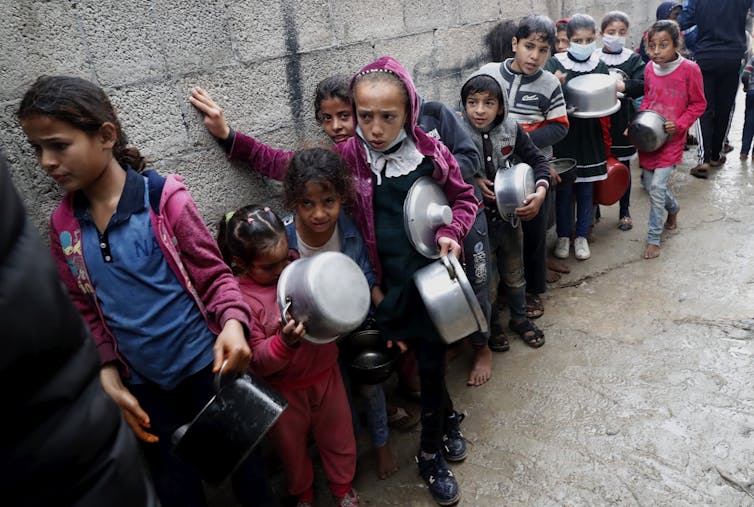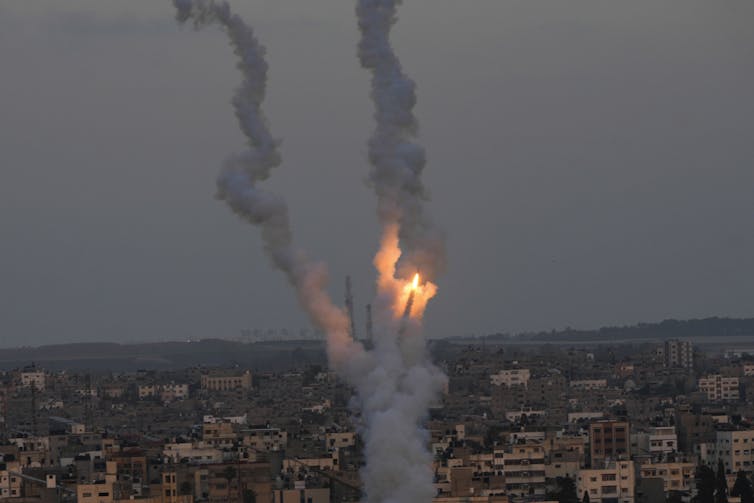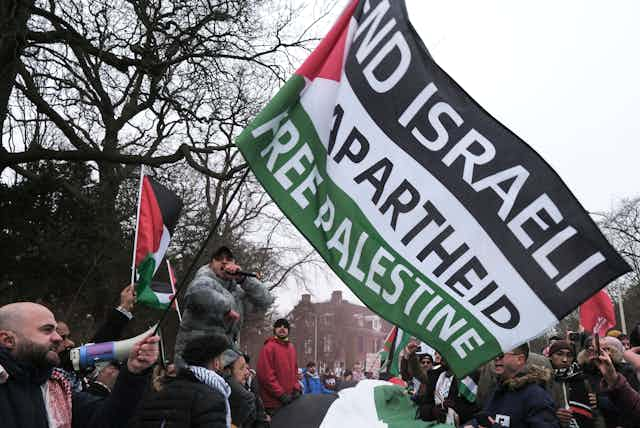A lot of political analysis is available on Israel’s indiscriminate bombing of Gaza. But economic analysis based on supply and demand also helps shed light on why conflict should be viewed systematically and structurally.
Such an analysis is at odds with the Israeli stance that ties its ongoing war in Gaza solely to the Oct. 7, 2023, attacks by Hamas, rationalizing the deaths of almost 24,000 Gazan civilians.
Research from the economics of religion allows us to cut through rationalizations and rhetoric to look at the issue systemically and structurally.
It helps us recognize the positive feedback loop that exists when state-sanctioned discrimination and persecution leads to perceived grievances and violence/terrorism, which in turn elicits more state repression, causing the vicious circle to continue unabated.
This seems to have been the case through the years of Israeli military campaigns against Gaza through various operations like Cast Lead, Protective Edge, Pillar of Defence and so on. These operations are interlinked with Hamas firing indiscriminate rockets in a seemingly endless cycle of violence.

Economics, not religion, fuels terrorism
American economist Laurence Iannaccone has written several papers on the economic theory of fundamentalism, religious extremism and what he calls the market for martyrs.
According to Iannaccone, the market for martyrs is an economic model that helps us understand the origin of violent extremism based on economic principles like rational choice.
In this market, the killers are suppliers and those who recruit them are demanders.
Based on his work, a typical terrorist, suicide bomber or extremist is neither poor, ignorant nor mentally unstable. This is because poor, ignorant or enraged people can be incompetent and risky; well-educated and mentally composed terrorists are required to carry out successful terrorist missions.
This is consistent with economic literature that shows there’s little direct connection between poverty or poor education and terrorism. In fact, Palestinian suicide bombers have had higher education and economic status than the average Palestinian.
According to Iannaccone, militancy is a consequence of the social and political environment, not religion. Fundamentalism becomes more appealing when people have been displaced or ill-served by secular governments.

Filling the void
That void is filled by groups like Hamas that offer public services and welfare programs. These violent groups also arise when basic civil liberties are undermined and economic opportunities are stifled.
According to another American economist, Michael Intriligator, terrorism is used by the weaker party in asymmetric warfare. That party usually has real or perceived grievances, and its motivation is not rooted in poverty or ignorance but in humiliation and retribution for past actions.
This resonates given the observation that Hamas perpetrators of Oct. 7 may have been children or minors throughout various Israeli operations in Gaza over the last two decades. The current bombing will likely instigate the same cycle, creating future militants.

Rational extremists
Israel’s far-right government has made its sentiments clear. Prime Minister Benjamin Netanyahu has evoked Amalek, described in the Hebrew Bible as an avid persecutor of Israelites. A former Israel envoy to the United Nations referred to Palestinians as “inhuman animals” and a right-wing Israeli lawmaker once called Palestinian children “little snakes.”
However, it’s important to note that the economic approach views extremists as rational, not psychopathic or animalistic. It also rejects the flawed argument that suicide bombers cannot be deterred because they have nothing to lose and nothing to live for.
It acknowledges that terrorists do have something to lose — and that they can be deterred.
An example amid the current conflict is the successful negotiations with Hamas that allowed the release of some Israeli hostages.

A pathologically nihilist, psychopathic organization would have perpetuated random mayhem amid the negotiations and subsequent hostage releases, but instead Hamas had political objectives. This suggests the group can be reasoned with — and deterred.
Further negotiations and addressing economic disparities and grievances would therefore be a much more fruitful strategy for Israel than indiscriminate bombing that will simply perpetuate the cycle of violence and shift the violence to the next generation.
In short, the economic approach would call for a ceasefire.
Supply and demand
Iannaccone argues that the market for martyrs is undermined not by inhibiting the supply of martyrs, but by checking demand.
This is because there are many sources of supply; kill some terrorists and others can be recruited. Imprisonment and execution have minimal impact.
What is needed to choke off the market for martyrs is to check demand by changing the political and economic environment through civil liberties, social services, political representation and economic freedom, all of which would inhibit religious radicals from embracing violence.
Look at Christian extremists in the United States for evidence. Social, legal, economic and political reasons would make religiously sponsored violence unprofitable for American Christian radicals, who would suffer loss to reputation, influence, membership and funding.
In short, the best way to tackle terrorism is not through military might but by ensuring that political grievances are heard and addressed.
Read more: History repeats itself: From the New Testament to QAnon
Market for drugs and arms
The market for martyrs can be tackled the same way as the market for illicit drugs by focusing on demand rather than supply — in other words, by addressing human needs, which is much cheaper than the costly spending on police and judiciary in the case of the war against drugs.
However, economic research indicates that focusing on supply is lucrative, since it has a significantly positive impact on defence and security industries in Israel.
In fact, weapons manufacturers have gained in share prices in the aftermath of the Hamas attack of Oct. 7. In short, the indiscriminate bombing of Gaza is profitable for war corporations even if the economic approach views it as counter-productive.
Tackling terrorism therefore requires not military aggression but providing public goods, respecting civil liberties and addressing political grievances, which for Palestinians is the long-festering Israeli occupation of their territory.
A ceasefire and eventually an end to the structural and systemic occupation will end the conflict. It’s not the supply of extremists, but demands, that must be addressed.

